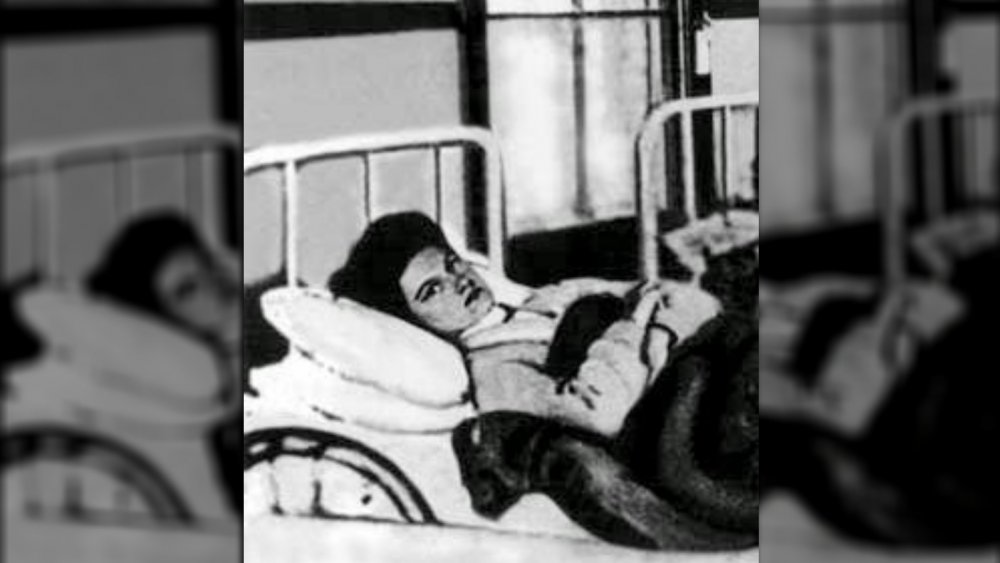The Untold Story Of Typhoid Mary
The story of Mary Mallon is a cautionary tale about ignorance, self-deceit, and cognitive dissonance. It's a story where one person's individual actions endangered thousands of lives and how personal freedom fought against the public's health. Typhoid Mary is the subject of many ethical debates and is the original case study for the asymptomatic spread of disease.
Mallon began her life in Ireland in the 1860s before moving to the United States in the 1880s, where she was employed in various forms of domestic work, settling in as a cook. Her chosen career path would play a big part in the typhoid outbreaks in the northeast around the turn of the 20th Century. Little did Mallon know that she was destined to become "Typhoid Mary," a name that would appear in medical dictionaries, cartoons, and jokes in her own time. It's also a name that's reemerging these days, and for very good reason.
Mallon became the cook for a wealthy banker, his family, and their servants in Long Island during the summer of 1906. Within three weeks of starting the job, one person fell ill with typhoid fever. By the end of August, six out of 11 people in the house were afflicted by the same condition. The concern over the outbreaks brought in George Soper, a disease investigator and self-proclaimed "epidemic fighter."
Discovering Typhoid Mary
Soper believed typhoid could be spread widely, like many other diseases, by an asymptomatic carrier. Mallon would prove his hypothesis. Mary became the subject of public health debate as to whether people should maintain autonomy while carrying an infectious disease. It's why you're not supposed to go to school with the flu. It's why you're supposed to wear a mask during the current pandemic. Soper investigated Mallon's work history and discovered a trail of typhoid following her through the houses in which she cooked, National Geographic tells us. Typhoid fever is caused a specific bacteria from the salmonella family and spreads mostly through food and water — the products of Typhoid Mary's work.
Typhoid typically causes symptoms like a high fever and severe diarrhea, but before Alexander Fleming discovered antibiotics in 1928, typhoid was frequently fatal. New York had several typhoid outbreaks around Typhoid Mary's time, in part because of inadequate public sanitation, in part because people rarely washed their hands, but Mallon was the first to cause an outbreak that could be traced back to a single individual. And she was asymptomatic — neither she nor anyone else knew she was sick. Everywhere that Mary went, the disease was sure to go.
Soper confronted Mallon, providing his evidence that she might be the cause of the illness, and asking her for fluid samples. According to Soper's account, at the National Center for Biotechnology Information (NCBI), Mallon responded by trying to stab him with a carving fork.
Denied she was ever sick
Eventually, she was escorted by the police to have the tests done and, yes, she tested positive. Despite the evidence, Mallon adamantly denied carrying typhoid because she had no symptoms. Mallon, a single carrier, is thought to be the cause of a 3,000 person typhoid outbreak in New York in 1907. She was asymptomatic and therefore dangerous, because she refused to accept that she was spreading the disease. She was held in quarantine following her positive test results, in a quaint cottage on North Brother Island. But that wouldn't last forever.
During quarantine, Typhoid Mary tested positive in 120 stool samples and seemed resistant to all types of treatments in those days before antibiotics. Mallon was freed from quarantine by a new health commissioner in 1910 under the agreement that she wouldn't handle people's food anymore. Good old Typhoid Mary agreed and, in her Typhoid Mary way, lied. She immediately went back to working as a cook.
Sick of being called "Typhoid Mary," she got a job cooking at Sloane Maternity in Manhattan under the name of Mary Brown. In three months, Mallon had managed to infect at least 25 patients and medical staff, according to another NCBI article. Needless to say, the authorities tracked her down and quarantined her on North Brother Island once again. This time, for the rest of her life; she died there in 1938.


